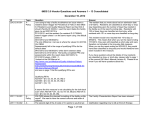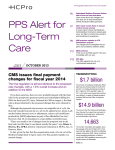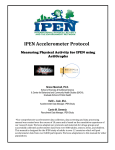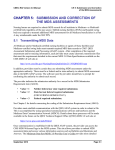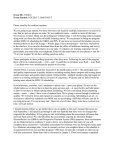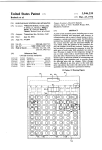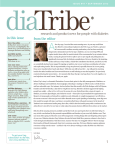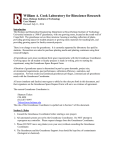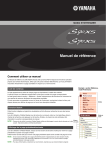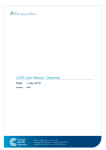Download Say hello to 3.0: The new MDS` effect on billers
Transcript
March 2010 Vol. 12, No. 3 Say hello to 3.0: The new MDS’ effect on billers The October 1 implementation of MDS 3.0 means big changes for SNFs. The latest PPS assessment will demand much attention from MDS coordinators, especially leading up to its debut and during its first few months of operation, as there are a variety of new features, including adjustments to regulations involving therapy and the HIPPS coding system. As a result, facilities should use the implementation of MDS 3.0 as an opportunity for process improvements, says Rena Shephard, MHA, RN, RAC-MT, C-NE, founding chair and executive editor of the American Association of Nurse Assessment Coordinators and president of RRS Healthcare Consulting Services in San Diego. “I really encourage everybody to take the MDS 3.0 as a brand-new assessment, not look at it as sort of an upgrade or a revision of the 2.0, because there’s so much in it that’s different,” Shephard says. IN THIS ISSUE p. 5 The details of default billing Knowing when to bill for the default rate isn’t easy. Get some tips here. Those differences will have far-reaching affects, which emphasizes the value of taking a fresh look at the systems that support Medicare Part A, says Shephard. The changes included in the new assessment also show that MDS coordinators will not be the only staff members who need to develop a thorough understanding of MDS 3.0, says Carol Maher, RN-BC, RAC-CT, director of clinical reimbursement at “I think there’s a lot in the Ensign Facilities, MDS 3.0 that’s going to Inc., in Mission Viejo, CA. “I think there’s a lot in the MDS 3.0 that’s going to affect billers,” Maher says. “I’ve already kind of affect billers. I’ve already kind of given my company a heads up that the business office managers have to be very much involved in the MDS 3.0 training.” —Carol Maher, RN-BC, RAC-CT given my company a heads up that the business office managers have to be very much involved in the MDS 3.0 training.” According to Chapter 6 With the January 13 release of Chapter 6 of the Resident Assessment Instrument (RAI) User’s Manual, Version 3.0, CMS sheds light on what that training will need to include. Based on the content, it appears the most signif- p. 6 HIPAA in the headlines Find out what happened with HIPAA in 2009 and how it will affect your SNF in 2010. p. 9 No longer a simple reimbursement issue Columnist Barbara Griffin-Gulliver explains the intricacies of same-day transfers. p. 10 LTC billing IQ Test your billing knowledge with these LTC scenarios and questions. p. 11 BALTC Q&A Columnist Lee A. Heinbaugh discusses the Medicare IVR system and hospital stay requirements. icant piece of the MDS 3.0 that will affect billers involves the HIPPS codes. “I think you can see from the table for the assessment indicator [see p. 4], this is a really big change,” Shephard says. “If you look at the table of HIPPS codes in the 2.0 manual, it’s a pretty simple thing.” It is important that billers know information is available in the new RAI User’s Manual, Shephard adds. It’s a resource that billing office staff members could certainly > continued on p. 2 Billing Alert for Long-Term Care Page 2 Say hello to 3.0 March 2010 < continued from p. 1 benefit from, especially as they attempt to build an early understanding of the changes in MDS 3.0. Among the changes present in the table are the new Other Medicare-Required Assessments (OMRA). As a result, billers might need to take it upon themselves to understand the function of the OMRAs with the MDS 3.0, which is a worthwhile undertaking, Shephard says. The billing office staff should know as “The end-of-therapy OMRA is required, but the much as possible about the start-of-therapy and end-of- start-of-therapy OMRA is not,” Maher says. “So it will therapy OMRAs and how they should be used because be interesting to see if facilities pick up on the start of that knowledge could go a long way in ensuring correct therapy OMRA.” reimbursement. It may be that MDS coordinators are so overwhelmed “It’s easy to say, ‘Well, the billers just put this on the by a whole new instrument and all the things that go claim so they don’t have to worry about the MDS.’ But with it that facilities miss out on some billing opportuni- the billers I know really want to have it in context and ties, says Maher. they really do want to understand what it is they’re doing so they can provide another level of cross-check be- Editorial Advisory Board Billing Alert for Long-Term Care Group Publisher: Emily Sheahan Associate Group Publisher: Jamie Carmichael Associate Editor: Justin Veiga [email protected] Kate Brewer, PT, MBA, GCS President Progressive Rehab Solutions Hartland, WI Laura McDonnell Corporate Business Manager Merrimack Health Group Haverhill, MA Karen Connor President and CEO Connor LTC Consulting Haverhill, MA Frosini Rubertino, RN, CRNAC, C-NE, CDONA/LTC Clinical Services Consultant LTC Systems Instructor HCPro Boot Camps Bella Vista, AR Joseph Gruber, RPh, CGP, FASCP Vice President & Clinical Products Specialist Mirixa, headquartered in Reston, VA Lee A. Heinbaugh President The Heinbaugh Group Lakewood, OH Elise Smith, JD Finance Policy Counsel Finance and Managed Care American Health Care Association Washington, DC Richard S. Iannessa Senior Vice President of Financial Operations SunBridge Healthcare Corporation Londonderry, NH Bill Ulrich President Consolidated Billing Services, Inc. Spokane, WA Elizabeth Malzahn Health and Wellness Finance Manager Covenant Retirement Communities Skokie, IL Wayne van Halem, AHFI, CFE President The van Halem Group, LLC Atlanta, GA Mary H. Marshall, PhD President Management and Planning Services, Inc. Fernandina Beach, FL fore the bill goes out,” Shephard says. Unlike with the MDS 2.0, the MDS 3.0 is able to calculate a non-therapy resource utilization group (RUG) and therapy RUG on a single assessment. In other words, if a resident enters a facility and does not begin receiving therapy until a week after admittance, the start-of-therapy OMRA comes into play. It allows for the calculation of the non-therapy RUG during the resident’s first week and, starting the day of therapy, the new calculation with the therapy RUG. “They’re going to want to know what these assessments are that affect the billing—the start of therapy, the end of therapy, and the MDS actually calculating in some cases the therapy RUG as well as a non-therapy RUG for Part A,” Shephard says. The potential of a RUG-IV delay MDS 3.0 wasn’t supposed to be the only introduction October 1. The new assessment was supposed to coincide with RUG-IV. However, at the time of publishing, there is an amend- Billing Alert for Long-Term Care (ISSN: 1527-0246 [print]; 1937-7452 [online]) is published monthly by HCPro, Inc., 200 Hoods Lane, Marblehead, MA 01945. Subscription rate: $259/year. • Billing Alert for Long-Term Care, P.O. Box 1168, Marblehead, MA 01945. • Copyright © 2010 HCPro, Inc. All rights reserved. Printed in the USA. Except where specifically encouraged, no part of this publication may be reproduced, in any form or by any means, without prior written consent of HCPro, Inc., or the Copyright Clearance Center at 978/750-8400. Please notify us immediately if you have received an unauthorized copy. • For editorial comments or questions, call 781/639-1872 or fax 781/639-2982. For renewal or subscription information, call customer service at 800/650-6787, fax 800/639-8511, or e-mail [email protected]. • Visit our Web site at www.hcpro.com. • Occasionally, we make our subscriber list available to selected companies/vendors. If you do not wish to be included on this mailing list, please write to the marketing department at the address above. • Opinions expressed are not necessarily those of BALTC. Mention of products and services does not constitute endorsement. Advice given is general, and readers should consult professional counsel for specific legal, ethical, or clinical questions. © 2010 HCPro, Inc. ment in the Senate health bill, the Patient Protection and Affordable Care Act, which would delay the implementation of RUG-IV to October 1, 2011. The amendment is not present in the House bill. Negotiations in Congress will determine whether the provision For permission to reproduce part or all of this newsletter for external distribution or use in educational packets, contact the Copyright Clearance Center at www.copyright.com or 978/750-8400. Billing Alert for Long-Term Care March 2010 Page 3 is included in the final bill sent to the president. Should it software should be checked routinely to make sure it’s be upheld and RUG-IV is delayed one year, a crosswalk correctly doing what it’s supposed to, she says. for the state case-mix systems between RUG-III and “People who are using the software need to use it RUG-IV would be used with MDS 3.0, which could add as a tool but not rely on it in the absence of their own an extra layer of confusion, Maher says. knowledge,” she adds. “Trying to crosswalk a RUG system with an entirely Quality assurance reviews should be completed pe- different MDS is going to be very different, especially if riodically to verify that the software is calculating it’s only going to be for one year,” she says. “That would properly. And to do this, billers and other SNF staff be very difficult for everyone to be able to manage.” members must have a thorough understanding of the The Senate bill states that the concurrent therapy ad- MDS 3.0. Being familiar with the material could save justment and changes to the look-back period to en- time as well as help billers avoid headaches should sure that only services provided after SNF admission are the software make an error or request action that is counted toward RUG placement, which are both compo- unnecessary. nents of RUG-IV, would still take place with the implementation of MDS 3.0 October 1. But postponing implementation of the remaining components, such as the increase from 53 groups un- Even with all of the changes that will take place due to the implementation of MDS 3.0 in October, Shephard says some things will remain the same. “The key things—like making sure the correct service der RUG-III to 66 groups under RUG-IV, would still have date is on there, which is the assessment reference date profound affects on billers, SNFs as a whole, and soft- on the MDS, and making sure that they have the correct ware vendors, says Jean Bean, RN, C, director of clini- number of days that they’re billing and that there aren’t cal services at Covenant Retirement Communities in any nonbillable days on there—none of that is going to Skokie, IL. be changing,” she says. “My biggest concern is that they’ve got all of these Despite the ease with which information is electroni- vendors who are ramping up for the electronic versions,” cally transferred, Shephard notes that someone from the Bean says. “They haven’t been given any leeway that billing office should continue to be present at weekly you can’t stop transmitting electronically, and if they’re Medicare meetings, as this promotes accuracy and serves building their software based on what they’re supposing as a chance to confirm any questionable material with to happen October 1 [2010], we could have a mess.” other SNF staff members. “The whole team—therapy, [nursing, the MDS co- Software strategies Not only is software instrumental in the eventu- ordinator], and the billing office already have to be in strong communication, but I think there’s going to be al implementation of RUG-IV, it is critical in the use of even more need for strong communication between MDS 3.0, as the HIPPS codes will be self-calculated by those disciplines after MDS 3.0 starts,” Maher says. n the software. Shephard says this will be a big help and should limit the chances of incorrect codes being used, especially within facilities that have their MDS software communicating with their billing software. This allows the HIPPS code to automatically populate the claim. However, that doesn’t mean person-to-person com- Questions? Comments? Ideas? Contact Associate Editor Justin Veiga Telephone 781/639-1872, Ext. 3933 E-mail [email protected] munication shouldn’t take place, says Shephard. The © 2010 HCPro, Inc. For permission to reproduce part or all of this newsletter for external distribution or use in educational packets, contact the Copyright Clearance Center at www.copyright.com or 978/750-8400. Billing Alert for Long-Term Care Page 4 March 2010 Assessment indicator second digit table Second Digit Values 0 Assessment Type Impact on Standard Payment Period Scheduled PPS assessment not combined No impact on the standard payment period (the assessment is not unscheduled). with another assessment If the second digit value is 0, then the first digit must be 1 through 6, indicating a scheduled PPS assessment or an OBRA assessment used for PPS. 1 Either an unscheduled OBRA assessment or ➤➤ If the ARD of the unscheduled assessment is not within the ARD window of any scheduled Swing Bed CCA PPS assessment, including grace days (the first digit is 0): Do NOT use if –– Use the Medicare RUG (Z0100A) from the ARD of this unscheduled assessment through the end of standard payment period. ➤➤ Combined with any OMRA ➤➤ Medicare Short Stay assessment ➤➤ If the ARD of the unscheduled assessment is within the ARD window of a scheduled PPS assessment, not using grace days: –– Use the Medicare RUG (Z0100A) from the ARD of this unscheduled assessment through the end of standard payment period. ➤➤ If the ARD of the unscheduled assessment is a grace day of a scheduled PPS assessment: –– Use the Medicare RUG (Z0100A) from the start of the standard payment period for the scheduled PPS assessment. 2 Start of Therapy OMRA ➤➤ If the unscheduled assessment gives a therapy group in the Medicare RUG (Z0100A): –– Use the Medicare RUG (Z0100A) from the unscheduled assessment’s earliest start of ther- Do NOT use if apy date (speech-language pathology services in O0400A5, occupational therapy in ➤➤ Medicare Short Stay assessment O0400B5, or physical therapy in O0400C5) through the end of standard payment period. ➤➤ Combined with End of Therapy OMRA ➤➤ Combined with unscheduled OBRA ➤➤ If the unscheduled assessment does not give a therapy group in the Medicare RUG (Z0100A), do not use the unscheduled assessment RUG for any part of standard payment ➤➤ Combined with Swing Bed CCA period. This is not a valid assessment and it will not be accepted by CMS. 3 Start of Therapy OMRA combined with ei- ➤➤ If unscheduled assessment gives a therapy group in the Medicare RUG (Z0100A): –– Use the unscheduled assessment Medicare RUG (Z0100A) from the earliest start of therapy ther an unscheduled OBRA assessment or a date through the end of standard payment period. Swing Bed CCA Do NOT use if ➤➤ If unscheduled assessment does not give a therapy group in the Medicare RUG (Z0100A), do not use the unscheduled assessment RUG for any part of the standard payment period. ➤➤ Medicare Short Stay assessment This is not a valid assessment and it will not be accepted by CMS. ➤➤ Combined with End of Therapy OMRA 4 Whether or not combined with unscheduled Use the unscheduled assessment Medicare non-therapy RUG (Z0150A) from the day after the OBRA assessment and whether or not com- latest therapy end date (speech-language pathology services in O0400A6, occupational therapy bined with Swing Bed CCA in O0400B6, or physical therapy in O0400C6) through the end of standard payment period. Do NOT use if ➤➤ Combined with Start of Therapy OMRA ➤➤ Medicare Short Stay assessment 5 Start of Therapy OMRA combined with End ➤➤ If unscheduled assessment gives a therapy group Medicare RUG (Z0100A): of Therapy OMRA 1. Use the unscheduled assessment Medicare RUG (Z0100A) from the earliest start of thera- 2. Use the unscheduled assessment Medicare non-therapy RUG (Z0150A) from the day after py date through the latest therapy end date. Do NOT use if ➤➤ Medicare Short Stay assessment the latest therapy end date through the end of standard payment period. ➤➤ Combined with unscheduled OBRA ➤➤ Combined with Swing Bed CCA ➤➤ If unscheduled assessment does not give a therapy group Medicare RUG (Z0100A), do not use the unscheduled assessment RUG for any part of the standard payment period. This is not a valid assessment and it will not be accepted by CMS. 6 Start of Therapy OMRA combined with End ➤➤ If unscheduled assessment gives a therapy group Medicare RUG (Z0100A): of Therapy OMRA and combined with either 1. Use the unscheduled assessment Medicare RUG (Z0100A) from the earliest start of thera- 2. Use the unscheduled assessment non-therapy RUG (Z0150A) from the day after the latest py date through the latest therapy end date. an unscheduled OBRA assessment or Swing Bed CCA Do NOT use if ➤➤ Medicare Short Stay assessment therapy end date through the end of standard payment period. ➤➤ If unscheduled assessment does not give a therapy group in the Medicare RUG (Z0100A), do not use the unscheduled assessment RUG for any part of the standard payment period. This is not a valid assessment and it will not be accepted by CMS. Source: RAI User’s Manual, Version 3.0, CMS. © 2010 HCPro, Inc. For permission to reproduce part or all of this newsletter for external distribution or use in educational packets, contact the Copyright Clearance Center at www.copyright.com or 978/750-8400. Billing Alert for Long-Term Care March 2010 Page 5 The details of default billing Although it may not be a SNF’s ideal means of re- the rules of when you can bill the default. Up until that imbursement, billing Medicare Part A for the default point, basically the industry standard was if you got a late rate—and doing so correctly—is financially critical to or a missed assessment, you just bill the default.” any facility. The rules that were specified in Transmittal 196 allowed Missing an MDS assessment based on the assessment for only two scenarios when facilities could submit a late schedule, which is determined by when the assessment assessment and bill for the default rate, a stark contrast to reference date is set, leaves a SNF with two options: re- the previous industry interpretation. In 2008, CMS cited ceive no payment for that time period or, the better op- three more circumstances in which SNF billers could use tion, file a late assessment to receive payment at the the HIPPS code “AAA00” on Part A claims to receive pay- default rate. ment at the default rate, bringing the total to five: However, choosing the latter isn’t always up to the ➤➤ The stay is less than eight days within a spell of SNF. The 2010 final rule did not include any changes illness (cited in Transmittal 196). If a resident expires from the default billing regulations that were clarified or is transferred within the first eight days of the ben- in the 2009 final rule. Those regulations limit a facility’s efit period, a SNF should prepare an assessment as eligibility to bill the default rate. best as possible so a HIPPS rate code can be assigned “When they first came up with default days, it was within the assessment schedule; however, if an as- the interpretation that anytime you didn’t have a com- sessment is not submitted in this case, a claim using pleted MDS, you could bill default days. CMS changed the default rate code is accepted. that, or clarified that, and they said, ‘No, that’s not true, ➤➤ The beneficiary requests a demand bill (cited in but there are some situations where default days can be Transmittal 196). If a SNF determines that care of a used,’ ” says Bill Ulrich, president of Consolidated Bill- beneficiary isn’t covered or if the beneficiary hasn’t ing Services, Inc., in Spokane, WA. met the SNF stay technical requirements, the facility There are five approved default billing scenarios. Out- is not required to assess the beneficiary for purposes side of those, if a MDS assessment was not completed in of classifying the individual into a resource utilization accordance with the assessment schedule, the SNF will group category. Instead, the SNF is eligible to submit not receive payment for that time period. a claim using the default rate code to ensure payment should the SNF reverse it’s coverage determination. Permitted default billing scenarios ➤➤ The SNF is notified on an untimely basis or is The consolidated billing final rule for fiscal year 2009 unaware of a Medicare Secondary Payer denial. set the precedence for situations in which it’s acceptable If an assessment hasn’t been performed and the resi- to bill for the default rate, which put to rest an ongoing dent exhausted primary payer benefits, the SNF can debate over the topic. bill at the default rate. That debate stemmed largely from Transmittal 196. Re- ➤➤ The SNF is notified on an untimely basis of the leased in March 2007, it was intended to update SNF PPS revocation of a payment ban. The date the pay- medical review policies. ment ban is lifted becomes day one of the Medicare “It all goes back to Transmittal 196,” says Theresa Lang, vice president of clinical services at Specialized Medical Services, Inc., in Milwaukee. “Transmittal 196 is really what started this whole thing. It’s where [CMS] came up with © 2010 HCPro, Inc. assessment schedule. ➤➤ The SNF is notified on an untimely basis or is unaware of a beneficiary’s disenrollment from a > continued on p. 6 For permission to reproduce part or all of this newsletter for external distribution or use in educational packets, contact the Copyright Clearance Center at www.copyright.com or 978/750-8400. Billing Alert for Long-Term Care Page 6 Default billing March 2010 < continued from p. 5 Medicare Advantage (MA) plan. If a SNF discov- ensure that both sides are receiving the correct informa- ers after discharge that a resident had disenrolled from tion, Lang says. the MA program, the SNF can bill at the default rate. Also, software vendors’ interpretation of the CMS default billing regulations could have an effect. All five exceptions were included in Chapter 6 of the “If billers don’t understand the clinical process and the Resident Assessment Instrument (RAI) User’s Manual, Version software does something incorrectly, it’s impossible [to 3.0, and will carry over to MDS 3.0 in October. correctly file a claim],” Lang says. Potential default billing issues can be taken care of Communicating for cohesiveness through simple due diligence, says Missy Tieken, vice Much of the past confusion involving default billing president of operations at Consolidated Billing Services. stemmed from a lack of understanding as to when the “I think they need to make sure that they are getting ev- default rate could be used, Lang says. Outside of that, how- erybody on the MDS schedule right from the get-go,” ever, there are other contributing factors, one of which Tieken says. “If they’re doing their Common Working may be a lack of communication between the billing office File checks and finding out what the benefits are with and clinical staff, she adds. Billers need to have access to these HMOs prior to residents coming, so if they’re ac- information that is necessary in terms of a resident’s stand- tually doing these verifications of benefits, I don’t think ing with Medicare Part A. By creating an open dialogue they’re going to have as much of an issue.” with nursing, this information can more easily be shared. Additional issues may occur if the billing and nurs- By verifying information up front, Tieken says SNFs will be more apt to avoid default billing complications ing departments are using different software programs, altogether. “It’s just a matter of them being proactive on as even more direct communication will be required to all of it,” she says. n HIPAA in the headlines in 2009: Anticipate impact in 2010 The quality, efficiency, safety, and privacy of healthcare in the United States were front-page news in 2009. Specific developments weren’t mere flashes in the use of federal stimulus money to advance the design, development, and implementation of a nationwide health information infrastructure that promotes the use pan; experts say the ripple effect will continue into 2010, and exchange of information via electronic health re- with long-ranging effects for most. cords (EHR). Let’s revisit the most significant events of 2009 and explore their potential effect in 2010. Congress included stiffer penalties for noncompliance with HIPAA, greater breach notification requirements, and expanded enforcement to address growing privacy HITECH Act and security concerns. For example, business associates ➤➤ The development: The Health Information Technology for Economic and Clinical Health (HITECH) Act, which was signed into law February 17, 2009, is (BA) now must comply with the HIPAA security rule and HITECH’s security provisions. Rebecca Herold, president of Rebecca Herold & As- one provision of the American Recovery and Reinvest- sociates, LLC, in Van Meter, IA, calls it one of the most ment Act of 2009. The HITECH Act aims to promote significant developments. © 2010 HCPro, Inc. For permission to reproduce part or all of this newsletter for external distribution or use in educational packets, contact the Copyright Clearance Center at www.copyright.com or 978/750-8400. Billing Alert for Long-Term Care March 2010 “There are many times more business associates than there are covered entities,” Herold says. Covered entities now must notify HHS of any breach- Page 7 privacy of patient information, even during its disposal. Specifically, HHS said CVS violated the privacy of millions of its customers when it: es no later than 60 days after learning of them. They also –– Failed to implement adequate policies and proce- must notify prominent media outlets in the state when a dures to appropriately safeguard patient informa- breach affects more than 500 individuals. tion during the disposal process ➤➤ What to do now: HHS began enforcing the amended breach notification provisions in February. Covered entities must fine-tune their processes now. –– Failed to adequately train employees to discard such information properly ➤➤ What to do now: The CVS fines made it clear that “This means that all personnel, volunteers, and agents HHS and FTC (and now OCR) currently operate under a need to know what to do if they discover a data breach,” sort of “zero tolerance” policy. The fines also served as a says Rebecca L. Williams, Esq., RN, partner at Davis warning that anyone violating the privacy rule is subject Wright Tremaine, LLP, in Seattle. to substantial fines and embarrassment. Covered entities had to amend their BA contracts by Pursuant to the HITECH Act, HHS issued guidance February 18. Organizations should work with their legal April 17, 2009, requiring providers to shred or destroy department to revisit existing contracts and ensure that any paper, film, or other hard copy media to ensure that they have the proper template for new ones. no one can read or reconstruct the PHI. Incentives for meaningful use of EHRs will begin in 2011. Congress would like stakeholders to purchase and implement EHRs in 2010 to prepare for 2011. Celebrity privacy cases publicized in California ➤➤ The development: The problem of curious hos- However, stakeholders may be slow to react because of pital workers who snoop inappropriately in medical up-front costs. records has long existed. During the past few years, it “The push for healthcare providers to go paperless has has become news as well. Celebrities, angry because created more electronic health records and repositories healthcare workers have sold their information to tab- than ever before,” says Herold. loids, have fought back in California’s newspapers and Take time to determine the timetable and EHR option that are most cost-effective for your organization. state legislature. Notable cases involved the late Farrah Fawcett in 2007 and Britney Spears in 2008. These high-profile Major pharmacy company fined for breaches ➤➤ The development: On February 18, 2009, HHS cases inspired a bill that Gov. Arnold Schwarzenegger signed into law January 1, 2009. The new law permits and the Federal Trade Commission (FTC) fined CVS the state to impose heavy financial penalties (as much Caremark Corp. $2.25 million for inappropriate disposal as $250,000) on healthcare providers who inappropri- of protected health information (PHI). An investigation ately peek in patients’ medical records. of CVS’ practices followed reports that the company dis- It didn’t take long for the state to flex its newfound carded patient information in industrial trash containers muscle. State regulators slapped the maximum penalty outside some of its stores. CVS failed to secure the con- on Kaiser Permanente’s Bellflower (CA) Hospital in May tainers, making the PHI accessible to anyone, according 2009. Regulators found that Bellflower failed to prevent to HHS. employees from snooping in the medical records of Nadya The privacy rule requires health plans, healthcare clearinghouses, and most healthcare providers (covered entities), including most pharmacies, to safeguard the © 2010 HCPro, Inc. Suleman, who gave birth to octuplets in January 2009. ➤➤ What to do now: These high-profile cases cast > continued on p. 8 For permission to reproduce part or all of this newsletter for external distribution or use in educational packets, contact the Copyright Clearance Center at www.copyright.com or 978/750-8400. Billing Alert for Long-Term Care Page 8 HIPAA March 2010 < continued from p. 7 a spotlight on inappropriate behavior in hospitals and pressure all providers to improve their processes. Con- ➤➤ Easier exchange of patient information when necessary duct a risk assessment to determine whether your or- ➤➤ Greater availability of patient information ganization is vulnerable. Consider strategies such as ➤➤ Appropriate data and transmission security monitoring system access logs or using “honeypots” to ➤➤ Better quality of care catch snooping staff members. ➤➤ Greater efficiency “It’s important for organizations to work harder to eliminate and detect snooping when workers look at the The work group also recommended that providers medical records of people they have no business looking allow patients to access their personal health records at,” says Michael C. Roach, Esq., of Meade & Roach, by 2013. Its initial recommendations proposed patient LLP, in Chicago. access by 2015. The new recommendations also require providers to OCR became responsible for HIPAA security rule enforcement ➤➤ The development: HHS announced July 27, participate in a national health data exchange by 2015. “The verdict is still out on how beneficial the final definition of meaningful use will be to healthcare,” says 2009, that it would transfer HIPAA security rule oversight Chris Apgar, CISSP, president of Apgar & Associates from CMS to OCR. CMS had overseen the rule since it in Portland, OR. “It can have great value, and it can also became effective in 2003. hamper [health information technology] adoption if it ➤➤ What to do now: Be prepared for greater enforcement of the HIPAA privacy and security rules; they both now fall under OCR’s umbrella. It is likely no coinci- is too expensive, requires too much, and/or is not well thought out.” ➤➤ What to do now: Privacy and security officers dence that a plan for increased penalties for privacy and must do more than conduct research and prepare to security violations is part of the HITECH Act that was en- implement EHRs. They also should prepare to strength- acted only four months earlier. en their policies because violations may directly affect OCR now will evaluate whether HIPAA security stan- EHR incentives and reimbursement. The work group dards preempt any state laws, impose financial penalties recommended that CMS withhold incentive payments for violations, and issue subpoenas pertaining to security until a provider resolves any pending HIPAA violation violations, according to HHS. charges. Meanwhile, providers must demonstrate meaningful Meaningful use—evolving definition, timetable, use by ensuring that their EHRs: and application ➤➤ Allow patients to access their health records quickly ➤➤ The development: In mid-July 2009, the Health IT Policy Committee approved a work group’s revised recommendations for defining the meaningful use of EHRs. This was the first step in a federal Medi- ➤➤ Implement at least one clinical decision support rule for a specialty or clinical priority ➤➤ Provide patients electronic copies of discharge instructions and procedures care and Medicaid program that uses incentives to re- ➤➤ Exchange health information where possible quire physicians’ and hospitals’ financial commitment ➤➤ Submit insurance claims electronically to EHRs. ➤➤ Verify insurance eligibility electronically when it is The final definition of meaningful use could lead to: © 2010 HCPro, Inc. possible n For permission to reproduce part or all of this newsletter for external distribution or use in educational packets, contact the Copyright Clearance Center at www.copyright.com or 978/750-8400. March 2010 Billing Alert for Long-Term Care Page 9 Same-day transfers: No longer a simple reimbursement issue Editor’s note: This article was written for BALTC by Barbara Griffin-Gulliver, director of Medicare policy at Zimmet Healthcare Services Group, LLC, in Morganville, NJ. amount. The SNF must petition the hospital for the payment. Most SNFs do not find this to be an easy task. SNFs can continue to submit same-day transfer claims for direct Medicare reimbursement if the resi- For many years, SNFs were able to collect Medicare payment for a Part A resident who returned to an acute care hospital on the day of his or her SNF admission. It was one of the rare situations when a patient did not have to be in the SNF bed at census-taking time in order for the SNF to receive payment for the daily care provided. In effect, SNFs were paid a cost report day for sameday transfer residents, but a SNF benefit day was not taken. A hospital benefit day was taken because that was where the individual resided at the time of mid- dent is discharged: ➤➤ Back to the hospital on the day of admission for a different medical reason ➤➤ To a hospital other than the one from which the resident was originally discharged Medicare has never reimbursed a cost report day for a same-day transfer resident who leaves the SNF against medical advice (AMA) or requests and receives transfer to another SNF on the day of admission. The first SNF may, however, privately bill the AMA resident for room night census. Special coding on the SNF claim (condition code 40) in and board using a facility invoice. It’s unnecessary to bill combination with a hospital discharge status of “02,” and Medicare for denials in this situation in order to privately the “from” and “thru” dates of the claim being the same, bill the resident. The first SNF may also submit a claim to permitted a cost report day payment to the SNF without Medicare for ancillary services provided to a resident who the claim overlapping with the hospital admission. The transfers to another SNF on the day of admission. n related manual reference can be found in the Medicare Claims Processing Manual, Chapter 6, Section 40.3.3. Although the reimbursement remains in place for this Illustration by David Harbaugh same-day transfer situation, the SNF’s ability to collect payment has become more complicated since 2005. Effective January 3, 2005, hospitals were required to bundle inpatient admissions for any individual who was discharged and was readmitted to the same hospital as an inpatient on the same day and for the same medical condition. CMS’ goal in issuing this new policy was to curb early hospital discharges for medically unstable beneficiaries and to avoid payment of two separate hospital PPS diagnosis-related group amounts. The related instructions can be referenced in CMS’ MLN Matters article, MM3389. With the implementation of this new policy, same-day transfer claims from the SNF overlap the combined hospital stays. CMS’ answer to this problem was to direct hospitals to pay the SNF for the Medicare cost report day © 2010 HCPro, Inc. “Would you say that your medical school experience helped develop your facility with unapproved abbreviations and prohibited acronyms?” For permission to reproduce part or all of this newsletter for external distribution or use in educational packets, contact the Copyright Clearance Center at www.copyright.com or 978/750-8400. Billing Alert for Long-Term Care Page 10 March 2010 LTC billing IQ Think you’re a long-term care (LTC) billing pro? Test your knowledge of SNF billing by answering the follow- a. True b. False ing questions, which are based on the facts and information found in this issue’s articles. 7. In which of the following scenarios are SNFs not allowed to bill for the default rate? 1. In the MDS 3.0, the start of therapy Other MedicareRequired Assessment (OMRA) and the end-of-therapy a. The stay is less than eight days within a spell of illness (benefit period) OMRA can potentially appear on the same assessment. b. The beneficiary requests a demand bill a. True c. The SNF is unaware of a same-day transfer b. False d. The SNF is notified on an untimely basis or is unaware of a beneficiary’s disenrollment from a 2. The amendment to delay the implementation of Re- Medicare Advantage plan source Utilization Group, Version Four (RUG-IV), to October 1, 2011, appears in the: 8. Beginning in 2005, hospitals were required to bun- a. House health bill dle inpatient admissions for any individual who was b. Senate health bill discharged and was readmitted to the same hospi- c. Both bills tal as an inpatient on the same day and for the same d. Neither bill medical condition. a. True 3. RUG-IV includes 53 groups. b. False a. True 9. SNFs can submit same-day transfer claims for direct b. False Medicare reimbursement if the resident is discharged: 4. The MDS assessment schedule is determined by when the assessment reference date is set. a. True a. Back to the hospital on the day of admission for a different medical reason b. To a hospital other than the one from which the b. False resident was originally discharged c. Both a & b 5. The consolidated billing final rule for which of the d. None of the above following fiscal years set the precedence for situations in which it’s acceptable to bill for the default rate? 10.Business associates are not required to comply with a. 2003 the HIPAA security rule and the Health Information b. 2005 Technology for Economic and Clinical Health (HI- c. 2007 TECH) Act’s security provisions. d. 2009 a.True b.False 6. Transmittal 196, issued in March 2007, listed five scenarios in which facilities were allowed to submit a late assessment and bill for the default rate. © 2010 HCPro, Inc. Are you stumped? Wondering whether you got the answer? Find the correct answers on page 12. n For permission to reproduce part or all of this newsletter for external distribution or use in educational packets, contact the Copyright Clearance Center at www.copyright.com or 978/750-8400. Billing Alert for Long-Term Care March 2010 Page 11 BALTC Q&A Editor’s note: “Q&A” was written by Lee A. Heinbaugh, ➤➤ Medicare Secondary Payer (MSP) president of The Heinbaugh Group, a long-term care consult- –– Name of MSP ing company in Lakewood, OH. To submit a question for up- –– Type of MSP coming issues, e-mail Associate Editor Justin Veiga at jveiga@ –– Effective and/or termination date hcpro.com. ➤➤ Medicare managed care plan information –– Name of Medicare Advantage plan I am new to working in a SNF billing office. I was reading through our policies and procedures for Medicare –– Effective and/or termination date ➤➤ Last billing date billing, and the Medicare Interactive Voice Response (IVR) ➤➤ Number of SNF days available system is mentioned several times. We use the Medicare ➤➤ Amount applied to the current year Medicare Part B online system to monitor our claims and verify eligibility; when should we be using the IVR system? The Medicare IVR system can be used for several tasks. Medicare eligibility can be verified using the IVR. Although this is often done using the Medicare Common Working File health insurance query access files, on the rare occasion when you can’t access the online system, the IVR system can be used as a backup. This way there is no interruption in the verification process. To use the IVR system to check eligibility, you will deductible ➤➤ Amount applied to the current year therapy limits ➤➤ Hospice –– Name of hospice –– Effective and/or termination date If your facility is receiving rejected claims due to an overlap in dates of service, the IVR will provide the name of the hospital and the dates the hospital billed to Medicare that are causing the overlap. This allows you > continued on p. 12 need to do the following: Identify the facility ➤➤ Facility NPI number ➤➤ Facility Medicare number or Provider Transaction Access Identifier ➤➤ Facility tax identification number MDS 3.0 is coming! Let HCPro help you prepare with consulting and custom education programs. Our team of experts have years of experience in the long-term care industry and are on the cutting edge of MDS 3.0 training. An HCPro consultant can perform a detailed analysis of your facility’s operations to help you best prepare for MDS 3.0’s effect. Provide resident information Bring an HCPro long-term care consultant to your facil- ➤➤ Medicare number ity for help in any of the following areas: ➤➤ Name ➤➤ MDS 3.0 preparation and modeling ➤➤ Date of birth ➤➤ Survey readiness ➤➤ Date of service ➤➤ Medicare compliance audits ➤➤ Documentation improvement Verify items ➤➤ Effective and/or termination date of eligibility for Part A and Part B ➤➤ Date of death © 2010 HCPro, Inc. For more information or a facility-specific needs analysis, contact Client Relations Manager Elizabeth Petersen at [email protected] or 781/639-1872, Ext. 3432. For permission to reproduce part or all of this newsletter for external distribution or use in educational packets, contact the Copyright Clearance Center at www.copyright.com or 978/750-8400. Billing Alert for Long-Term Care Page 12 BALTC Q&A March 2010 < continued from p. 11 to review your census and correct your claim accordingly. our residents in an observation status and do not admit Or in the event there is a mistake, you will know who them to the hospital as an inpatient. Where can we find to contact in order for corrections to be made to the dates the documentation we need to support what qualifies of service used on their claim. as an inpatient hospital stay? The other reason to use the IVR is to reactivate claims that are not available online. Some claims can be activat- This is a common problem. The three-day prior hos- ed using the IVR, but you may still need to contact the pital stay requirements are included in Chapter 8, provider relations department for some claims. The use of the IVR system to verify benefits is easy and available any time. It is always good to have a back- Section 20.1, of the Medicare Benefit Policy Manual. This chapter can be found on the CMS Web site at www.cms. hhs.gov/manuals/Downloads/bp102c08.pdf. up plan to access the eligibility information to be sure Please review and reproduce this section and share you have the necessary information when making an with your staff members and colleagues. It is imperative admission decision. that the resident meet this qualification for coverage un- Note: If you enter the Social Security number using der the Medicare Part A program. n the telephone buttons, identify the alpha character by pressing “*,” then the button that corresponds with the LTC billing IQ answer key alpha character, and then pressing the number for the 1. a. True position of the alpha character. Example for the alpha 2. b. Senate health bill suffix A: *, 2, 1. 3. b. False 4. a. True We do billing for a SNF and must find the regula- 5. d. 2009 tions for the three-day qualifying hospital stay 6. b. False dates. We need to communicate to our nursing and admission staffs that we cannot bill Medicare Part A if the resident was not admitted to the hospital for three consecutive days. The hospitals in our area sometimes keep BALTC Subscriber Services Coupon ❏ Start my subscription to BALTC immediately. 8. a. True 9. c. Both a & b 10. b. False Your source code: N0001 Name Options No. of issues Cost ❏ Electronic 12 issues $259 (BALTCE) N/A ❏ Print & Electronic 12 issues of each $259 (BALTCPE) $24.00 Order online at www.hcmarketplace.com. Be sure to enter source code N0001 at checkout! 7. c. The SNF is unaware of a same-day transfer Shipping Total Sales tax (see tax information below)* Grand total For discount bulk rates, call toll-free at 888/209-6554. *Tax Information Please include applicable sales tax. Electronic subscriptions are exempt. States that tax products and shipping and handling: CA, CO, CT, FL, GA, IL, IN, KY, LA, MA, MD, ME, MI, MN, MO, NC, NJ, NM, NV, NY, OH, OK, PA, RI, SC, TN, TX, VA, VT, WA, WI, WV. State that taxes products only: AZ. Please include $27.00 for shipping to AK, HI, or PR. Title Organization Address City State Phone Fax ZIP E-mail address (Required for electronic subscriptions) ❏ Payment enclosed. ❏ Please bill me. ❏ Please bill my organization using PO # ❏ Charge my: ❏ AmEx ❏ MasterCard ❏ VISA ❏ Discover Signature (Required for authorization) Card # Expires (Your credit card bill will reflect a charge to HCPro, the publisher of BALTC.) Mail to: HCPro, P.O. Box 1168, Marblehead, MA 01945 Tel: 800/650-6787 Fax: 800/639-8511 E-mail: [email protected] Web: www.hcmarketplace.com © 2010 HCPro, Inc. For permission to reproduce part or all of this newsletter for external distribution or use in educational packets, contact the Copyright Clearance Center at www.copyright.com or 978/750-8400.













